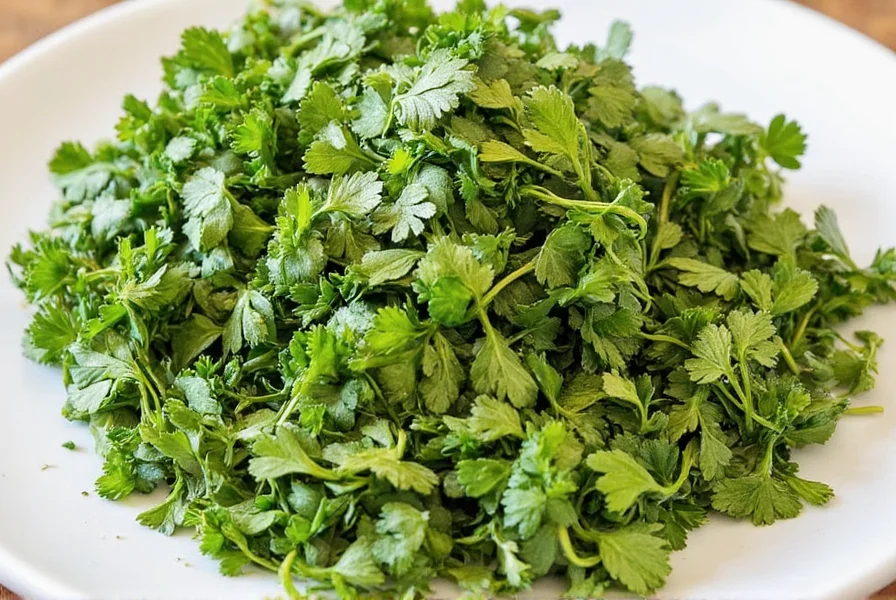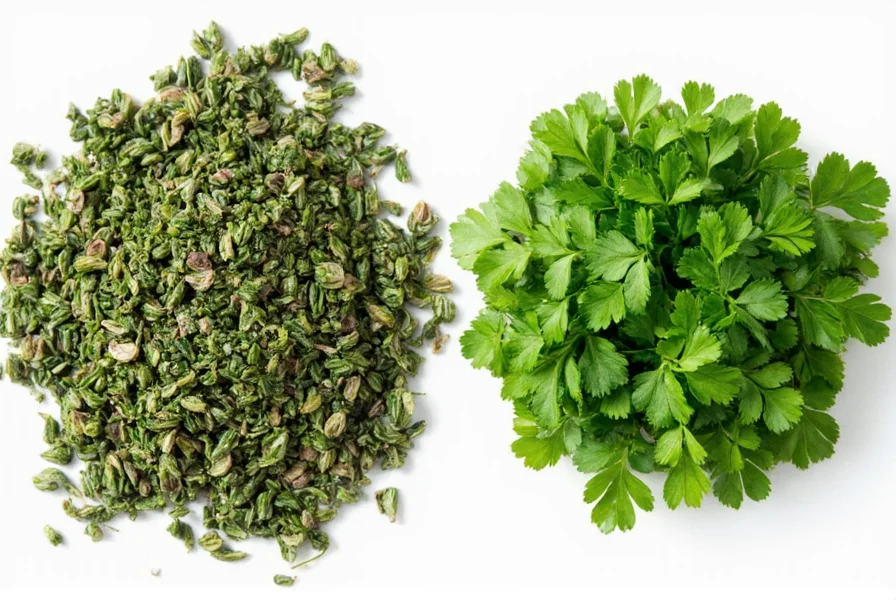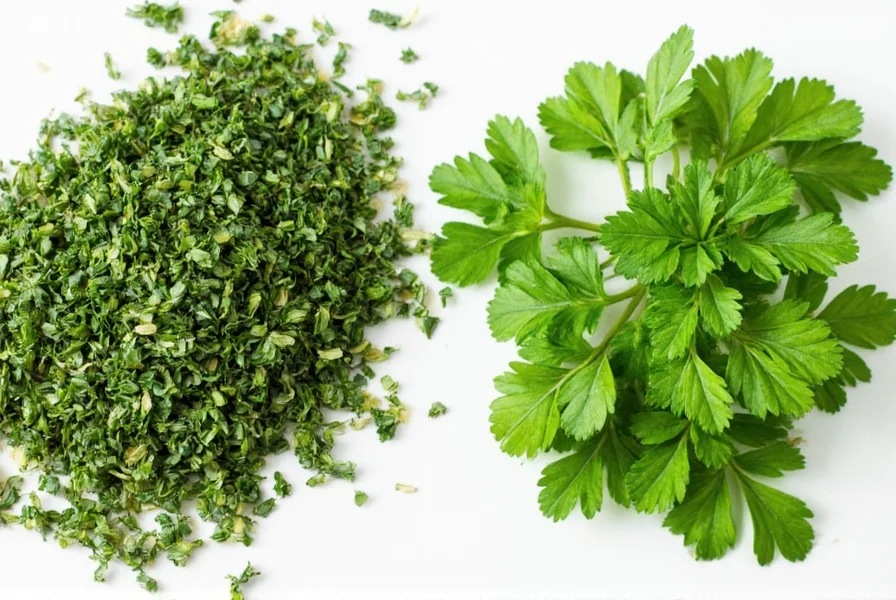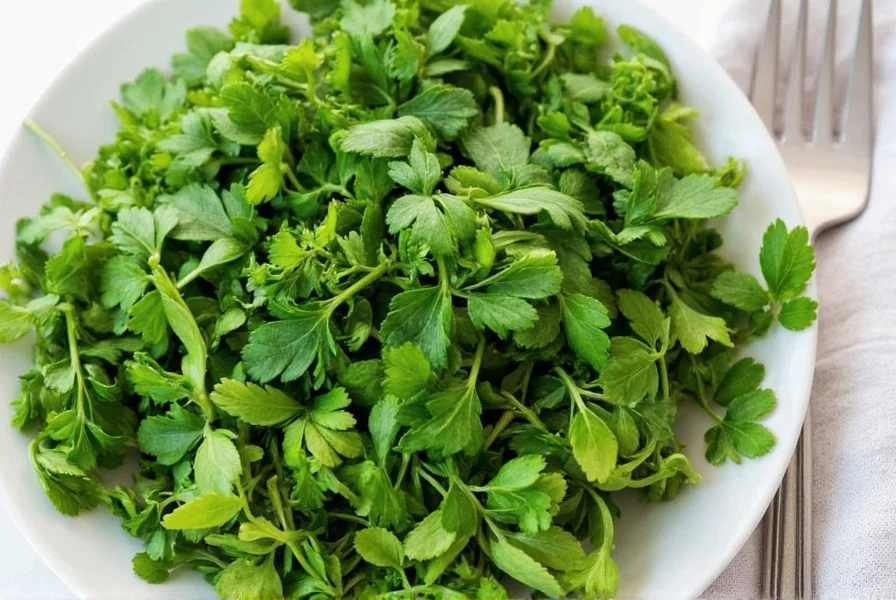What's the Correct Fresh to Dried Parsley Conversion Ratio?
The standard conversion ratio is 3:1 — meaning 3 tablespoons of fresh parsley equals 1 teaspoon of dried parsley. This is because drying concentrates the flavor, so you need less dried parsley to achieve the same taste in your dishes.

Whether you're out of fresh parsley or looking to use your dried stash, this guide will help you substitute correctly without compromising flavor.
The Great Divide: Fresh vs. Dried Parsley
Parsley comes in two main forms: fresh and dried. Each has distinct characteristics that affect flavor, texture, and usage. Understanding these differences ensures optimal results in your cooking.
| Aspect | Fresh Parsley | Dried Parsley |
|---|---|---|
| Flavor Intensity | Bright, grassy, vibrant | Subtle, earthy, mellow |
| Texture | Crispy, leafy | Crumbly, powdery |
| Shelf Life | 3–5 days refrigerated | 6–12 months sealed |
| Best For | Garnishes, salsas, raw dishes | Slow-cooked meals, soups, stews |
Parsley Equivalent: What's the Conversion?
Here's the precise conversion ratio you need for accurate substitutions:
- 3 tablespoons fresh parsley = 1 teaspoon dried parsley

This ratio maintains flavor balance because dried herbs are concentrated. Think of it like replacing fresh coffee beans with instant granules — you need less to achieve the same intensity.
When to Use Which: Practical Applications
Knowing the right time to use each form prevents flavor imbalances in your dishes.
Use Fresh Parsley When:
- Making chimichurri, pesto, or herb-based sauces
- Garnishing tacos, hummus bowls, or roasted vegetables
- Adding brightness to salads, tomato-based sauces, or cold soups
Use Dried Parsley When:
- Simmering soups, stews, or braised dishes
- Seasoning meat rubs, marinades, or dry spice blends
- Making long-baked casseroles, pasta sauces, or baked goods
Buying Guide: Choosing the Best Parsley for You
Smart shopping ensures maximum flavor and freshness in every use.
For Fresh Parsley
- Look for vibrant green leaves with no wilting or yellowing
- Check stems — they should feel firm and moist
- Opt for flat-leaf (Italian) parsley over curly for stronger flavor

For Dried Parsley
- Ensure packaging is tightly sealed and stored away from light
- Color should be deep green, not faded brown
- Smell test: It should have a distinct, herbaceous aroma
Top Picks:
- Fresh Pick: Farmer's Market Italian Flat Leaf Bunch
- Dried Pick: McCormick Culinary Grade Dried Parsley
Pro Tips & Tricks with Parsley Equivalents
Elevate your cooking with these expert techniques:
- Add dried parsley early in cooking to allow flavors to fully infuse
- Freeze chopped fresh parsley in ice cube trays with olive oil for easy meal prep
- Mix dried parsley with breadcrumbs or cheese for instant flavor boosters
- Use fresh parsley as a base for compound butters or zesty vinaigrettes
- Don't toss parsley stems — blend them into stocks or sauces for extra depth
Delicious Recipes Using Both Forms
1. Creamy Chicken Noodle Soup (Dried Parsley)
- Ingredients: Chicken broth, noodles, carrots, celery, garlic, 1 tsp dried parsley
- Cooking Tip: Add dried parsley with the vegetables to infuse the broth deeply.
2. Mediterranean Grain Bowl (Fresh Parsley)
- Ingredients: Quinoa, roasted veggies, feta, chickpeas, 2 tbsp chopped fresh parsley
- Cooking Tip: Toss parsley on top before serving to keep that crisp freshness.
Frequently Asked Questions About Parsley Equivalents
What is the exact conversion ratio between fresh and dried parsley?
The standard conversion is 3 tablespoons fresh parsley = 1 teaspoon dried parsley (3:1 ratio). This accounts for the 85-90% water content in fresh parsley that's removed during drying, concentrating the flavor compounds. Always measure dried parsley by volume, not weight, for accurate substitutions.
Can I substitute dried parsley for fresh in all recipes?
You can substitute using the 3:1 ratio, but results vary by dish. Dried parsley works best in cooked applications where it can rehydrate (soups, stews, sauces). For raw applications like garnishes, salads, or salsas, fresh parsley is always preferable for its vibrant color, texture, and brighter flavor profile.
Why does the conversion ratio exist between fresh and dried herbs?
The conversion ratio exists because fresh herbs contain 85-90% water, while dried herbs have most moisture removed. This concentration means dried herbs pack more flavor per volume. The 3:1 ratio compensates for this difference, helping maintain balanced flavor in your recipes without overpowering them.
How long does dried parsley retain its flavor?
Properly stored in an airtight container away from light and heat, dried parsley maintains good flavor for 6-12 months. After this period, it doesn't spoil but gradually loses potency. Signs of diminished quality include faded color (from deep green to brownish) and weak aroma when opening the container.
Can I make my own dried parsley at home?
Yes, you can easily dry fresh parsley at home. Wash and thoroughly dry the leaves, then either hang small bunches upside down in a warm, dry, dark place for 1-2 weeks, or spread leaves on a baking sheet and dry in the oven at the lowest temperature (150°F/65°C) for 2-3 hours. Once completely dry and crumbly, store in an airtight container. Homemade dried parsley often has superior flavor to store-bought versions.
Does the type of parsley affect the conversion ratio?
The conversion ratio remains consistent regardless of parsley type (flat-leaf/Italian or curly). However, flat-leaf parsley generally has a stronger flavor than curly varieties in both fresh and dried forms. When substituting, you might need slightly less flat-leaf parsley than curly to achieve the same flavor intensity.
Conclusion: Parsley Problems No More!
Whether you're team fresh or team dried, now you know how to switch between the two with confidence. Keep this handy guide on parsley equivalents close by and never let a missing bunch ruin your next meal again.
Remember: Flavor matters, but flexibility is key. Happy cooking!











 浙公网安备
33010002000092号
浙公网安备
33010002000092号 浙B2-20120091-4
浙B2-20120091-4